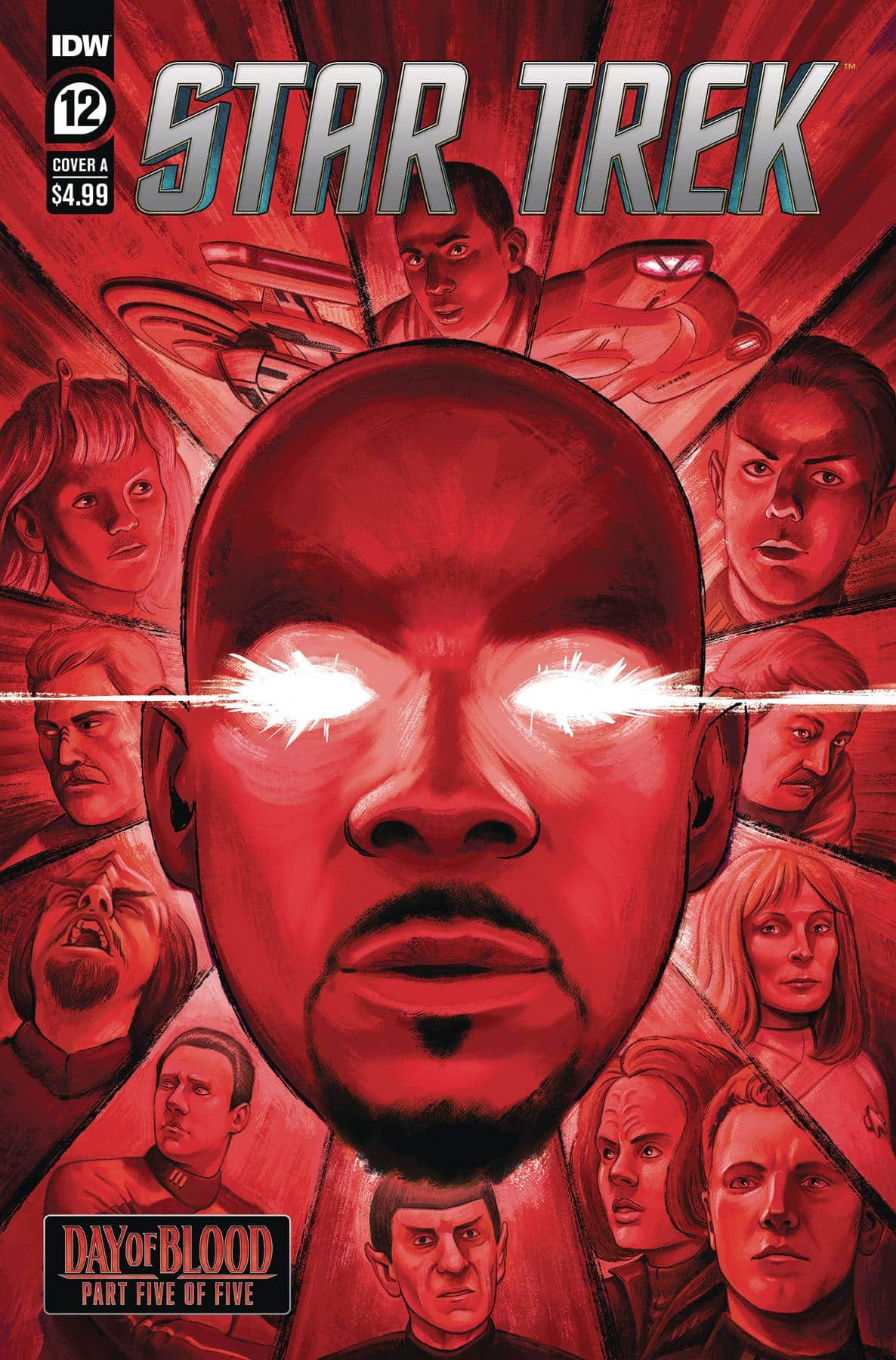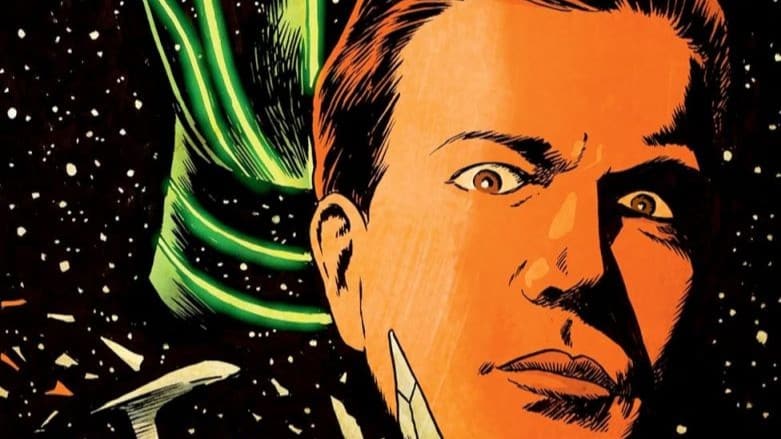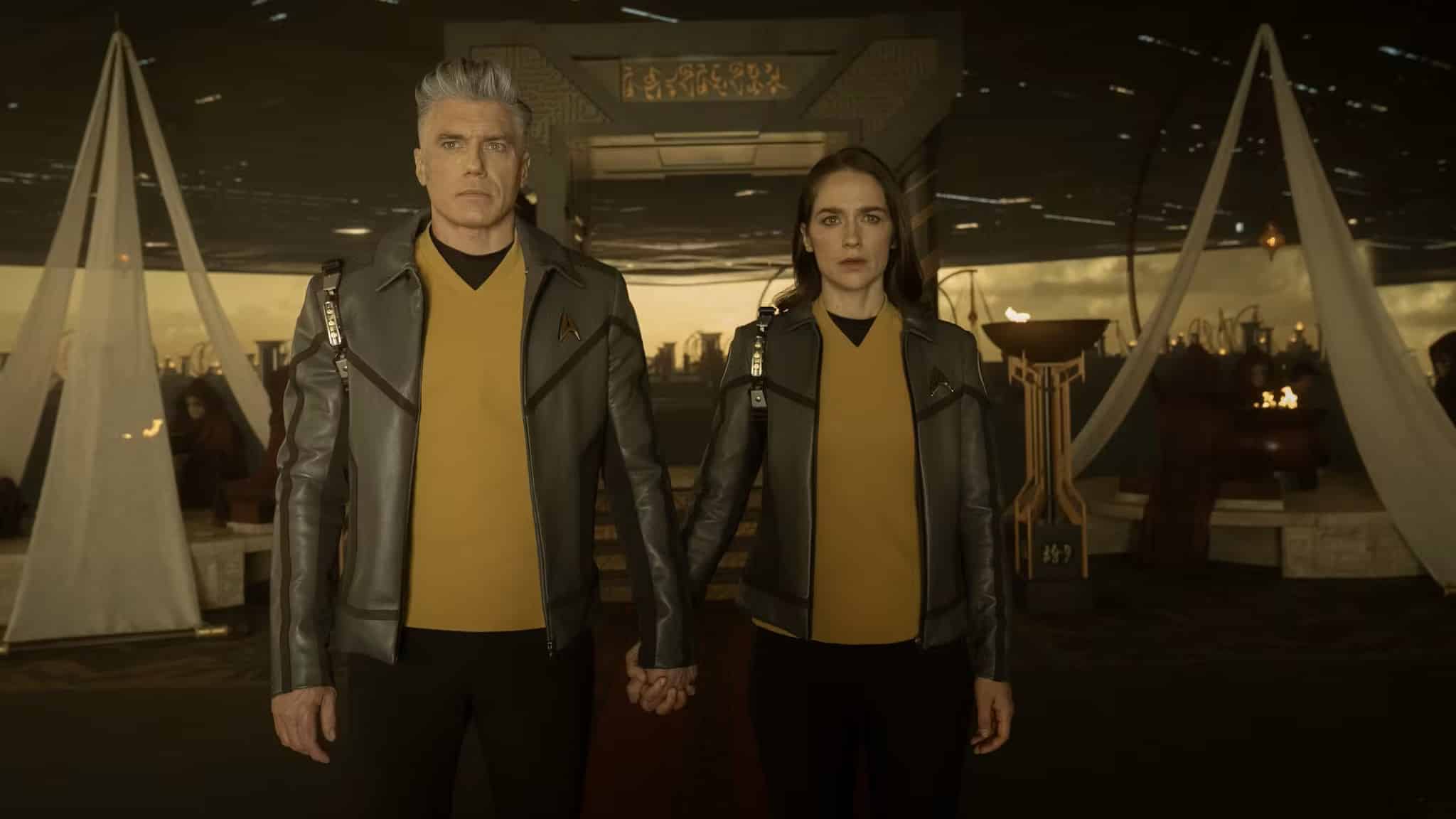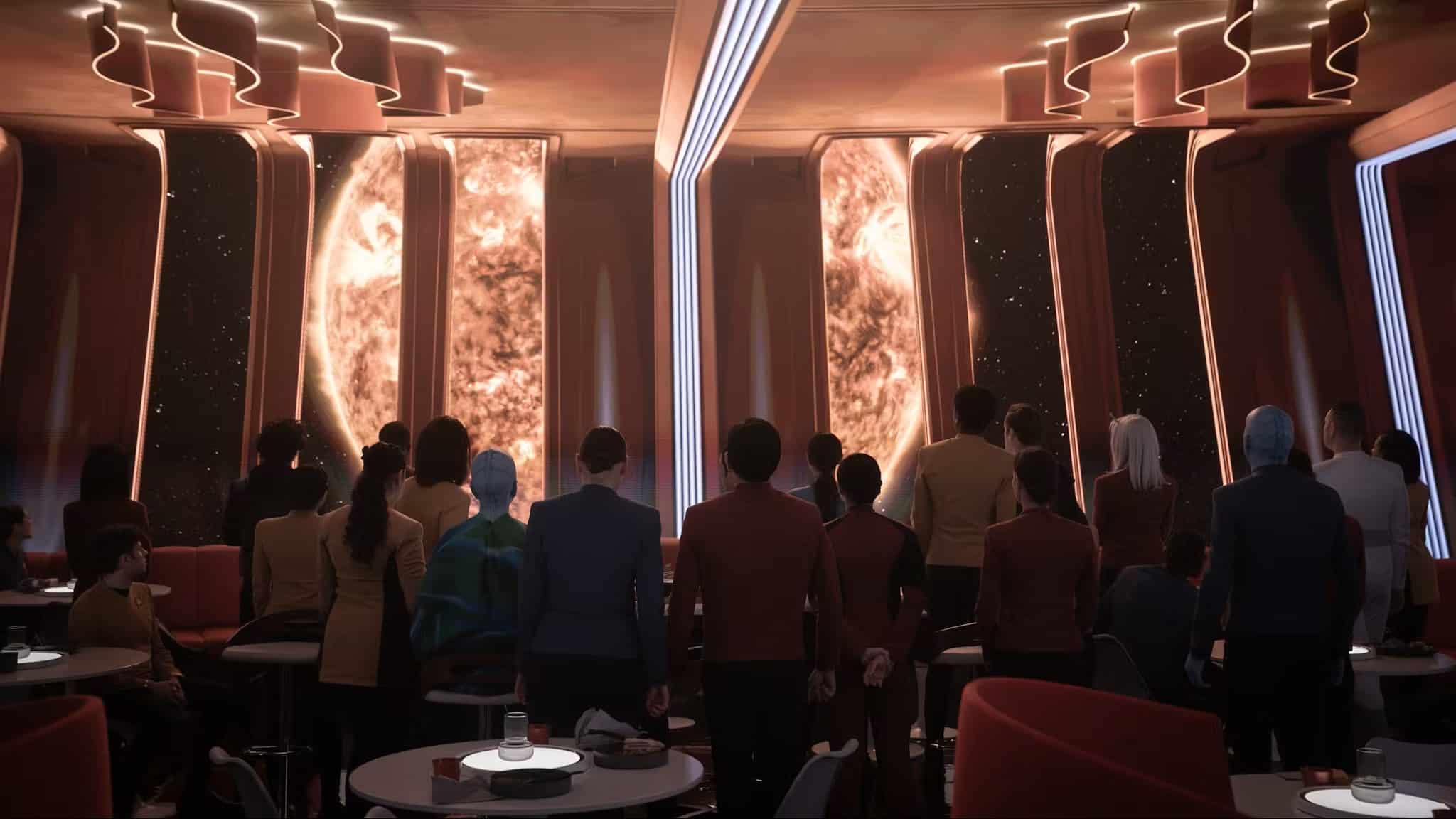The Day of Blood has led to the ultimate showdown, both on the surface and in orbit above Qo’noS!
Star Trek: Defiant #7, written by Christopher Cantwell, with art by Ángel Unzueta, colors by Marissa Louise and letters by Clayton Cowles.
Star Trek #12, written by Collin Kelly & Jackson Lanzing with art by Ángel Unzueta, colors by Marissa Louise and letters by Clayton Cowles.
Star Trek: Day of Blood: Shaxs’ Best Day written by Ryan North, with art by Derek Charm and letters by Clayton Cowles.
Mark Turetsky: The Day of Blood is coming to an end. But like all great Klingon rituals, I can’t face my duties alone. Tony, will you join me as cha’DIch as we review these final three issues?
Tony Thornley: This crossover has been a sprint and I love it. It’s the Star Trek movie we deserved but never got. Great stuff.
Fight Father, Fight Son

Mark: One thing I’ve appreciated over the course of this crossover, is that while the plot includes members of the cast of both series, Defiant has remained something of a Worf-centric story in its format: the captions are told from Worf’s point of view, the data pages were written by Worf and his grandfather last month, and this month written by Alexander at two very different points in his life.
The first one we see is written seemingly just before the Day of Blood, denouncing Worf and all that he cares about. The second is a school essay written by Alexander while he was in third grade aboard the Enterprise. The two pieces, taken side by side, are heartbreaking. Also, the hints we get of young Alexander’s interior life, where he writes things like, “sometimes my father gets angry, but I like it when he’s calm,” tell such a story. And not necessarily a good one for Worf as a father. And, well, we see where his parenting led Alexander here.
Tony: In the context of the episodes themselves, Alexander episodes on TNG were always a slog. Worf — generally a good-to-great character — was always slightly out of character in them, even if his aloofness made sense. Alexander was petulant. His DS9 episodes were better, but they were still sparse.
This issue completely recontextualizes all that. I don’t think it makes those episodes better, but there’s a path from there to here. And it’s absolutely heartbreaking. We’ve compared so much of this story to the rise of fascism and the radicalization of youth. Defiant is now exactly that metaphor with personal stakes for one of our most beloved characters.
Mark: I can definitely see writer Christopher Cantwell, as a father, purging some personal demons in this. It explores one’s worst fears as a parent. And yes, fascists love to prey on and recruit disillusioned young men just like Alexander. I appreciate how much this especially builds on Alexander’s characterization in DS9’s “Sons and Daughters,” where he enlisted in the Klingon fleet during the Dominion War, serving aboard the Rotarran (an episode which also contains one of my favorite awkward lines of dialogue, where Martok tells Worf, “When a father and son do not speak, it means there’s trouble between them.” Really, Martok? You think?)
While Worf and Alexander work out their problems in a fairly combative manner, Sisko confronts Kahless, who has him blasted with his godkiller weapon from his ship, and, like the burning bush before him, he burns but is not consumed. Is he immune because it’s Powered by the Prophets™?
Tony: I thought this was incredibly interesting. It almost seems to me that it’s a little bit of that, but also the last of Ben Sisko’s deity is basically being burnt off. But that’s getting into next issue a touch because Benjamin barely shows up after he gets blasted.
Cantwell capture’s Ben’s voice so well, and so consistently to Jackson Lanzing & Colin Kelly. I think we’ve said before, this line feels so much like the first two years of Marvel’s Star Wars relaunch. The continuity is tight, but the style and characterization is too, even if Cantwell still has a distinct voice from the Hivemind.
The Worf and Sisko scenes were so impactful that I had completely forgotten that a ton of stuff happened aboard the ships!
I think I’ve said it to you before, one of the big problems with Trek comics is that the ship-to-ship stuff gets lost. That’s why they’re stronger when they’re centered on away missions, on-ship drama and more thinky sci-fi. I absolutely take that back with Unzueta’s work here. Man, he makes the dogfight between the Bloodwing, Defiant and Theseus look cool.
Mark: I love just how mixed up the crews have gotten: the Defiant has Torres in the captain’s chair, Paris at the helm and T’Lir, Sato and Shaxs, while the Theseus has Spock, Ro, Data, Descheeni, Crusher, X and Sela. It would have been fun if the solution they come up with in the finale depended on who was on which ship, but I’ll take this.
And Captain Meyerson is back! And he’s gone totally Red Path, like how survivors of Saw movies then go on to become Jigsaw killers themselves, I guess. I like the solution the crews come up, using the “Lying Vulcan” con. Look at the precise thing that Spock tells Meyerson, “Please consider this. We are prepared to hand over the Orb of Creation to you and the Red Path in exchange for the lives of our respective crews.” See the trick? He’s not outright lying here. He’s merely asking Meyerson to “consider this” as a possibility, a hypothetical.
Tony: A) Love a lying Spock. It’s a very good trope that I will never tire of.
B) Man I wish this Meyerson revelation would have come sooner. I’m way more interested in a Red Path that’s as diverse as the Federation, and “Day of Blood” could have used an infusion of that. What is drawing Romulans, Cardassians and now humans into the fold? Is it fear? Are they agreeing with the philosophy? Do they see themselves backing the winner of a fight? I want to know more about this.
And the revelation would have been fine if he hadn’t been taken out so quickly by Spock, B’Lanna and Paris’ incredibly clever gambit with the fake Orb (actually a Trilithium bomb), used to take out the final Bloodwing. Great action, but could have done with more.
Mark: I think Kahless has been recruiting disaffected young men of all galactic races over Subspace YouTube. But in Meyerson’s case? He’s just a full-on Klingon weeb.
Meanwhile, back on Qo’noS, Cantwell follows the time-honored comics tradition of characters fighting to the death taking the opportunity to have a debate. The duel isn’t about figuring out who has the best Mok’bara, it’s about whose ideas will win out. Remember last month, when Worf’s grandfather talked about how he’ll never trust a fearful Klingon? Here, it’s much more clearly spelled out in the final moments of Worf and Alexander’s duel. Through combat, Worf achieves an epiphany: “fear wreaks havoc on the Klingon mind. It drives us to dishonor. We mask our fear with violence and bloodshed. We call it strength. We are wrong.”
Tony: Worf’s journey into his Klingon-hood is always an interesting plot point. Here, Cantwell nails it. Just great stuff. Worf lays down his weapon for his son’s sake, allowing him to take out some of his anger on him, and then shows him compassion. The panel of Alexander’s tearful clarity is perfectly executed by Unzueta and Louise. You can see the tears in Alexander’s eyes.
I kind of feel like we should have seen Kahless stabbing Alexander as a given. He clearly doesn’t see any member of the Red Path as anything but a means to an end, just a tool to use against his foes. That makes this whole moment so tragic — Alexander is a true believer up until this point, then Kahless sees that his control has been… maybe not broken, but cracked? But that’s the time for Kahless to cast Alexander aside, and use his death to shock Worf into letting his guard down.
If Sisko hadn’t interrupted, I fully believe Kahless would have attempted to murder Worf while he was mourning Alexander.
Mark: And let’s make things clear here, Alexander is dead. Worf is lifting his eyes to Sto-vo-kor, screaming a warning to all there that a warrior is about to arrive. And Alexander’s dying words are, “Father… I am… sorry… I am… afraid.” In his dying moments, Alexander is once again that third grader, worried that he’s disappointed his father with his fear. It’s utterly heartbreaking.
Tony: It’s a fantastic moment and sets up the next phase of Worf’s journey.
Second Genesis

Mark: The finale of this event, as it turns out, is fairly light on incident: with the Bloodwings defeated, the mixed crews of the Defiant and the Theseus work together to harness the power of The Orb Of Creation to defeat Kahless’ Orb Of Destruction. But there’s quite a bit of good stuff in the execution. First off, remember back in our review of Star Trek #9, when I said Sisko reaching out to his mother was redolent of Christ imagery? Well, this issue has him quoting Matthew, 27:46 almost verbatim, “Mother. Oh, Mother. Why have you forsaken me?” and not for nothing, but Matthew here is pulling that phrase from Psalm 22: “Eli, Eli, l’mah sh’vaktani?” (“My God, my God, why have you forsaken me?”). Like DS9 before it, this comic isn’t shying away from religious imagery, which you’ll find throughout this issue.
Tony: I mean, for all else it is, these series are also a bit of a war between belief and disbelief, so I like it.
This moment, paralleling messianic imagery, does remind me about a debate within the Trek fan community. There is a contingent that thinks that religion has been outlawed or banned in the universe, or even just that the Federation has grown past faith as a higher power. I think, even though this is not to a deity we know on Earth, this series has shown there’s room for faith in the Federation and its allies. It’s fascist belief that has no room. Unfortunately, modern Christianity doesn’t see the difference, and that has colored so many modern people’s view of persons of faith. Faith without unrighteous dominion can be a good thing.
Mark: To those people, I say if humanity on Trek has moved past religion altogether, I just point to Chakotay. Despite the fact that Jamake Highwater, the Native American “expert” they hired for Voyager was a fraud and a scammer, Chakotay the character was still a religious man. And I’m glad that Lower Decks has been showing human crewmembers with religious headwear.
But back to the Bajoran religion, Sisko’s orb vision here is finally taking the form of the visions from the show: cryptic words delivered by the important people in his life as well as people involved in his current situation. I carped a little bit about how The Prophets seemed only to be speaking in great big unbounded text in previous issues (especially since we didn’t get to see important people from T’Lir’s past when they touched the Orb themselves), and this spiraling double page spread that Unzueta delivers is just bravura stuff.
I love how it almost forces you to turn the comic as you read it, following the spiral to the middle, to Spock, overseeing the creation of the Orb interface. And then Sisko’s catching Kahless’ would-be killing Bat’leth blow. There’s something Matrix-y about that moment, the hero who has moved past the laws of the universe, who can shrug aside mundane weapons.
Tony: And that’s both a literal and a symbolic victory. The Bat’leth is one of the most popular props from Trek. To see Ben stop one just shows where he’s at right now. It’s an action beat, but it’s an action beat with layers. Ben doesn’t just catch the Bat’leth though. He’s given strength by gaining confidence in his crew. And it’s not Ben that rallies the crew, it’s their own belief and determination. The strength of these characters give him strength.
“It’s not my gods you’re fighting, Kahless. It’s my crew.”
Mark: Spock’s credo here, “Risk is our business,” comes from the TOS episode “Return to Tomorrow,” where members of a long-dead race want to inhabit the bodies of Kirk, Spock and Lt. Commander Mulhall (played by Diana Muldaur) so that they can build android bodies for themselves to inhabit. The “risk is our business” speech is peak TOS, and especially, it’s peak Kirk. I highly recommend checking it out. Shatner’s delivery is amazing, and the choice to show it in one long, unbroken close-up that slowly zooms in on Kirk’s face (with only one brief cut-away to McCoy). It’s particularly impressive if you look at what might have been with the alternate take of this scene, which uses a three-shot of Kirk, McCoy and Spock which robs the speech of so much of the bombast Shatner brings to it in his close-up.
Tony: TOS is probably my biggest blind spot in Trek because I missed a lot of it, so I missed the reference. Again though — we’ve said this a dozen times — it shows how the line is structured for fans of all types: slightly more casual down to the really hardcore fans.
Mark: The biblical analogy here continues, where Spock, Scotty and Crusher note the Orb of Creation’s similarity to the Genesis Device from Wrath of Khan and The Search for Spock. It’s the key moment in Trek where human invention transcends the technological and verges on the theological (I’m not talking to you, Star Trek V!), and it’s nice they’re acknowledging it here, especially since this sets up Alexander’s Spock-like resurrection.
Tony: I totally missed that this was a resurrection. I had thought Alexander might still be hanging on and the Genesis Wave woke him up. The idea that this infusion of life continued into Alexander and revived him is a great touch. I also love that as the Orb of Creation blasted the temple, it suddenly comes to life with greenery. It’s a touch of beauty added to the tragedy of the preceding moments.
Mark: Alexander’s resurrection is a phenomenal scene, and it completes Worf’s epiphany. In Defiant #7, Worf likens fear to a hole within yourself. Kahless has tried to fill that hole with power and violence. Here, Worf takes it one step further: the Klingon worship of Kahless is toxic, because, as he puts it, “Kahless did not create honor. He only bound it to violence[…] He is just a man.”
I have to wonder how much Kelly and Lanzing were aware of Worf’s character development in the final season of Picard when they wrote this, because it ties in so well with the Zen, pacifistic Worf we got there. Nor do I know how well it ties in with his characterization in Nemesis, which is set one year after this, because that would involve me watching Nemesis a second time. I can’t wait to see how this realization will affect him going forward in Defiant.
Tony: Yeah, and the team hints at that in the epilogue that follows Kahless’s retreat. I like that Kahless knows he’s beat, and he doesn’t just retreat— he RUNS. The crews have run him off on a rail. They’ve won. And that’s when it shifts into the epilogue — which interestingly is done in two scenes and a pair of data pages — again showing how well the creative team knows how to use that storytelling tool. It allows them to cover a ton of information in a little bit of space, and actually let the other two scenes breathe a bit.
Mark: The twin cliffhangers, with Sela using Ceti Eel (the nightmare brain worms from Wrath of Khan) toxin to exert control over Martok on the one hand and Lore taking command of Kahless’ scattered forces on the other, leave a lot of space for more stories coming out of this event. But there’s another phaser that ensign Chekov has left on the mantelpiece, and that’s the fact that, while the mixed crew rigged up the Orb of Creation to defeat Kahless, Captain Sisko still hasn’t communed with it himself. The final scene of Star Trek #10, the big build-up before Day of Blood, began with him warily considering the orb for an entire page, but he’s still never opened the box. Make like a wizard and ponder the Orb, Benjamin!
Tony: We’ve gotten a couple teases of what’s coming next, and I think that has to be one of the next big plots. But first, the crew has to return to Earth, and I’m excited to see what that will bring. I know Lanzing and Kelly have teased Janeway and I have to think Kim will put in an appearance too. So what else is next?
Mark: That and clearly someone (Kahless? Lore?) is going to aim that weapon at the Celestial Temple. SURELY.
Tony: I think my last comment on the crossover is that I wish Rosanas was back for this last issue. Unzueta was a rock star drawing four of the five issues, but I think this conclusion could have used a slight infusion of another style to give the final chapter just a touch of “oomph.” It did look absolutely fantastic though.
A Good Day To Die, Or The Best Day To Smash Fash?

Tony: The philosophical question posed by this one shot — is Shaxs’ best day also our best day? I posit, the answer is yes.
I am so glad that we got this one-shot. The rest of the crossover is so deep, and this is just plain fun. It’s got the tone of Lower Decks, with a level of ultra-violence that I don’t think even that series will ever get to. It’s just a story of an anti-fascist murdering a bunch of evil fascists. The only disappointment is that the only members of the Red Path that Shaxs fought were Klingons. I would have loved to see a few Romulans, Cardassians, or even a moment with the converted Captain Meyerson.
Mark: Agreed! There’s something almost uncanny about the more realistically grounded Shaxs we’ve gotten in the comics thus far. It’s great to see him just cut loose entirely and engage in this delightful mayhem. And where Cantwell, Kelly and Lanzing have been relatively subtle using Kahless to comment on current events through Star Trek politics, North hits this theme like a one-eyed Bajoran brandishing a pipe: THE BAD GUYS ARE FASCISTS.
One quibble with the title, though, in the Lower Decks season one finale, “No Small Parts,” Shaxs exclaims, “This is the best day of my life!” as he flies Rutherford onto the Pakled ship. Now, I’ll accept that this comic represents Shaxs’ best day so far, but it isn’t his best day period.
Tony: I think North addressed that at one point — he has other “best days”, but they’re all ties with one another.
In comparison to the rest of the series, this is fairly linear. Shaxs has a goal or two, he’s determined that nothing will stop him from accomplishing them, and if he can kill some fascists on the way, all the better. And for all the death and dismemberment, I’m so glad North and Charm had so much fun and made every fight different. He transports away limbs. He blows up ships. He used a Bat’leth as a boomerang. He melts a mech.
This is so much fun.
Mark: Tons of fun. Recommend. A+. Go and buy. I hope it gets included in a snazzy collection of this event that will surely come out someday.
Tony: Yeah, even if it isn’t included chronologically, which could disrupt the flow of the story a bit, I get that, it needs to be in the hardcover. It’s a damn delight.
Bloody Bits
- Blazin’ Bev was certainly prepared for more blood. Her 757 liters of blood would fill almost 5 barrels!
- They made a sex ghost reference! THEY MADE A SEX GHOST REFERENCE!
- Charm not only does an admiral job emulating the art style of Lower Decks, he gives us Ro, T’Lir and Sato in that style as well, the latter two of which we will almost certainly never get to see in that style again.
- Kahless calls Worf and Sisko “The Ambassador and the Emissary,” both of which mean “representative.” In his mind, they’re just stand-ins and he’s the real thing.
- Torres “harnessed the power of a protostar.” It might just be a reference to the Voyager episode “Heroes and Demons,” but it might also be a nod to Star Trek: Prodigy.







